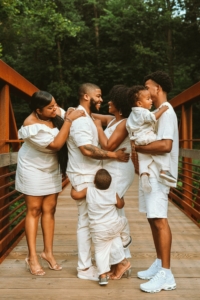Becoming a Blended Family
 Sometimes you find yourself in the middle of bringing together two families. For whatever reason, you are now navigating a home life with a mixture of feelings and habits. What seems like an angry child could be a child who is scared of losing everything that was comforting to them. Creating a home for a blended family takes patience and grace. Newport Beach Christian Counseling offers guidance and support to help families navigate these transitions with understanding and compassion.
Sometimes you find yourself in the middle of bringing together two families. For whatever reason, you are now navigating a home life with a mixture of feelings and habits. What seems like an angry child could be a child who is scared of losing everything that was comforting to them. Creating a home for a blended family takes patience and grace. Newport Beach Christian Counseling offers guidance and support to help families navigate these transitions with understanding and compassion.
Each person in the family is affected by the new dynamic of a blended family home. The children may feel as if they have no voice, the parent may feel like it’s all a mistake, and the step-parent may feel like an intruder. Even though all of these different feelings and mindsets may be happening, there are ways to ensure that your home is blended in a way that conveys love and peace.
By wisdom a house is built, and by understanding it is established. – Proverbs 24:3, ESV
Where do we start?
Blending families happen because of loss in some way or another. Whether your spouse has passed away or you are surviving divorce, you have gone through a painful time. This pain is not just for adults. Our children feel the pain just the same and they have to know that this new change in their home life is not going to negate how they feel about their other parent.
First, you should make sure that each child knows that this new family dynamic does not change how you feel about them. One of the easiest ways to help this would be to allow them to express any frustration with the new dynamics of the home. Even if you don’t want to hear how they are having an issue with the other parent, allow them to express what’s going on.
Fear not, for I am with you; be not dismayed, for I am your God; I will strengthen you, I will help you, I will uphold you with my righteous right hand. Isaiah 41:10, ESV
Children and blended families
Some say that children are resilient to changes in their lives. While it may be true that they seem to bounce back after some life-changing events it isn’t always easy for them. They still have to learn to navigate the change in the best way they can. Losing a parent is traumatic for children. Whether it is by divorce or death, not having that parent in their everyday life can cause lasting emotional problems.
some life-changing events it isn’t always easy for them. They still have to learn to navigate the change in the best way they can. Losing a parent is traumatic for children. Whether it is by divorce or death, not having that parent in their everyday life can cause lasting emotional problems.
Hearing “You’re not my parent!” or “I don’t have to listen to you!” are a few of the more common statements step-parents may hear when the family is just starting to create a new space for this new family. Even though these may be the most prevalent words that you hear during the first few weeks or months of learning to blend families, they don’t have to be statements that you hear forever.
Take time to talk to them and try to understand why they are so angry and hurt by this new home. Don’t expect them to always be okay. Some children have a hard time with change even though it may be the best thing for them. Let them voice what’s going on with their emotions. God understands that life happens and He will guide you through this rocky time with your child as well.
Two are better than one, because they have a good reward for their toil. For if they fall, one will lift up his fellow. But woe to him who is alone when he falls and has not another to lift him up! Again, if two lie together, they keep warm, but how can one keep warm alone? And though a man might prevail against one who is alone, two will withstand him – a threefold cord is not quickly broken. –
Ecclesiastes 4:9-12, ESV
Parents and blended families
As parents of a blended family, it is your responsibility to ensure that the home is healthy and safe. The first aspect of creating a healthy home is to make sure that you are committed to a solid marriage. The family starts with marriage. When the marriage is solid and respectable, then the home will follow suit. The hard thing about blended family and marriage is that you are having to learn to be a couple while adjusting to parenting.
Being able to create a solid relationship with your spouse before blending families is essential in understanding how each of you intends to handle the issues that will come up in the beginning. You have to assure each other that you will support each one’s decisions even if it hurts your parent’s hearts. When you promote your marriage as a team that wants what is best for everyone, the likelihood of continued problems will decrease.
When you create a home that revolves around respect and compassion it will make the transitions easier for everyone. Learning to interact with each other civilly is key to overcoming any tension that may be present in the dread of facing changes.
Respect given and taken between all family members is a must if there is to be peace within the new family dynamic. It will also take an understanding that everyone handles change differently. These things will allow for growth in all areas of the family dynamic.
How to begin a blended family
When you know that it is time to begin the process of moving into a new home with your new family, you should consider how to make this process easier for everyone.

Take time to consider how the change will affect everyone. Too many changes at one time can be considerably overwhelming for all of those involved, especially the children. Don’t rush into any lifelong changes without considering how your children may be handling the previous change.
Discuss parenting styles beforehand. Bringing families together that use two different parenting styles is an open door for problems. Not only can this cause a problem between parents, but the children will also begin to show signs of resentment and anger.
Don’t rush the relationship with the children. As you and your spouse begin to create this new home, remember to take time to get to know the children. Don’t expect them to be eager to accept the new dynamic. They will begin to see your role in their life and how that will look for them.
Do life as a family. Make time to have family time with everyone, and then go a step further. Include them in everyday life. Allow them to interact with the other parent in real-life situations such as housework, shopping, and Bible study.
Make respect a priority. Whether or not the children like your new spouse does not negate respect in the home. Along with respect make sure that ultimatums are not tolerated by either parent. This also goes for the parents. Each of you should be the example of respect and grace that your children will need to see as they learn to become a blended family.
Challenges of blended families
As with anything that combines two things, there will be challenges. Creating a blended family is not exempt from challenges even if you have followed the above ideas to help create a peaceful transition. These are just a few of the more common challenges you may face as you create a blended family.
 Relationship changes. When children find themselves in a new relationship, they may seem distant and reserved. The changes in the family will bring changes in the roles of each person. A child who was the youngest may now find themselves as being the oldest.
Relationship changes. When children find themselves in a new relationship, they may seem distant and reserved. The changes in the family will bring changes in the roles of each person. A child who was the youngest may now find themselves as being the oldest.
While this may seem like a small thing, it is a big change for a child to adjust to. When a child loses the uniqueness of their role in the family dynamic, they may need more time to adjust to losing that part of their identity.
Age differences. When you bring together two families you are bringing the likelihood of children being closer in age than they would naturally be. This can be a challenge when it comes to celebrating birthdays as individually as possible.
Experience as a parent. It’s a challenge when both of you have been a parent, but when you have a spouse that has never been a parent it can bring another challenge to the dynamic. As a person with no parental experience, your spouse may not understand the various developmental stages that children experience.
Changing family traditions. One of the hardest things for children to accept is new traditions that replace the old ones. Children grow accustomed to traditions when it comes to holidays and vacations. Changing these dramatically can have a negative impact. It’s best to comprise between the two families.
Activities and events. Trying to plan events with a blended family can be trying due to considerations that must be met. When you have to consider visitation rights for divorced parents it can be hard to plan an event for everyone to enjoy. Children may have a hard time accepting that activities change because of the need to include everyone.
Bonding and growing in a blended family
Creating a blended family that works and grows together is possible. When you focus on keeping faith-based values within your home, you will promote a healthy environment in which everyone can bond. Don’t allow the roles to become confused with the overall picture of being a family. Newport Beach Christian Counseling provides faith-centered guidance to help blended families build strong, loving relationships rooted in understanding and unity.
You will need to create boundaries for children as well as parents. These boundaries will allow for healthy relationships to be built. Be sure to keep all parents involved in the child’s life. Co-parenting children of divorce is a key factor in helping them heal from the experience of divorce.
“Family at the Beach”, Courtesy of Patricia Prudente, Unsplash.com, CC0 License; “Family”, Courtesy of Josue Michel, Unsplash.com, CC0 License; “Bath Time”, Courtesy of CDC, Unsplash.com, CC0 License; “Happy Family”, Courtesy of Dylan Sauerwein, Unsplash.com, CC0 License




